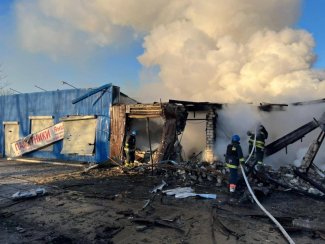Western tanks won’t reach Ukraine before spring. Day 340 of the war

Bakhmut, along with villages north and southwest of the town, is still the site of the heaviest armed clashes. Ukrainian forces have repulsed further attacks on Ivanivska on the road from Bakhmut to Kostiantynivka, but are not able to use it as a supply route. The Russians were also said to have unsuccessfully renewed attacks south and east of Siversk. Fighting continues on both sides of the road linking it to Bakhmut, in the area of Avdiivka itself, and in an arc west of Donetsk. The invaders have also renewed their attempts to break through the enemy’s defences in Vuhledar.
According to the Ukrainian General Staff, in the 26 January attack on energy infrastructure, the enemy used 70 rockets, 47 of which were shot down. During individual attacks in the following days, rockets fell on Zaporizhzhia, Kostiantynivka and Kharkiv, among other locations. Russian artillery and aviation continued to strike at the positions and facilities of the enemy’s forces along the line of contact and in the border regions, mainly in the Sumy region. 29 January saw particularly intense shelling of Kherson, with civilian casualties (three killed, eight wounded). In turn, the targets of the Ukrainian strikes included Ilovaysk and a road bridge in the Melitopol area.
Ukrainian servicemen have arrived in the UK and will begin their training to operate Challenger-2 tanks in February (London plans to deliver the vehicles in late March). The Ukrainian army also expects to receive Leopard-2A6s from Germany by the end of the first quarter. Soldiers have arrived in Germany to train on the Marder infantry fighting vehicles which Berlin promised in early January. The head of Spain’s defence ministry announced his country would send Leopard-2A4s during the spring, although the exact number is still unconfirmed. According to media outlets there, Madrid intends to train 54 Ukrainian soldiers in their use. Canada has confirmed the delivery of four Leopard-2A4s, although Denmark will not hand its tanks over; that country’s defence minister has said the army does not have enough tanks to spare. Poland, in turn, has pledged to deliver another 60 T-72 and PT-91 tanks in addition to the Leopards it has already promised.
According to the Washington Post, the American M1A2 Abrams tanks will arrive in Ukraine in late 2023 or early 2024. They are yet to be produced, and will differ from standard Abrams in having weaker armour, without the alloy that contains depleted uranium. The Americans will donate the rest of the battalion’s equipment from Pentagon stocks.
The heads of the defence ministries of France and Italy have agreed to purchase a total of 700 Aster-30 missiles for use with SAMP/T air defence systems. However, they did not reveal how many of them Ukraine would receive along with the promised battery. The new military aid package published by the German government includes IRIS-T missiles (the number of which was also not given) and various types of vehicles.
Spain’s El País published an interview with Col. Yuri Ihnat, spokesman for the Ukrainian Air Force Command, in which he said that Kyiv expects to receive two fighter squadrons (24 aircraft in total) from its partners, but that Ukraine’s priority is to acquire F-16s. He later dismissed these words, claiming translation errors, but nevertheless later repeated the claims in a milder form. According to Ihnat, the Ukrainian Air Force is already preparing to receive the new planes: the bases where they will be stationed are being chosen, and the Air Force’s commander Gen. Mykola Olyeshchuk has approved a list of pilots to be trained in operating the planes. Other representatives of the Ukrainian government, including foreign minister Dmytro Kuleba, have also spoken in a similar vein during recent days.
The disclosures about fraud in the processing of military contracts have drawn a reaction in the US. On 26 January, the Undersecretary of State for Political Affairs Victoria Nuland announced that auditors were in Kyiv to check how US military and financial aid was being used. She added that the resignations of officials suspected of corruption are a strong signal that the Ukrainian government is determined to stamp out any irregularities. Earlier, an inter-agency working group on oversight in Ukraine was established, which will seek to identify the areas where there is the greatest risk of misconduct in the distribution of support.
On 27 January, the head of Ukraine’s State Border Guard Service, Andriy Demchenko, indicated that the Russian-Belarusian joint exercises have been going on for more than a month. Their goal is to create tensions near the border with Ukraine and force the enemy to keep forces and equipment in that area, so that they cannot be diverted to other sections of the front. There are still no signs that a strike group is being formed near the border.
The Security Service of Ukraine reported on 27 January that an attempt by Russian hackers to break into the city surveillance cameras in one of the country’s border regions had been thwarted. They wanted to connect to the video surveillance system in houses and along traffic routes through the wi-fi networks in residential buildings; that could have made it easier for them to obtain data on the activity of law enforcement officers and the movement of military equipment. The SBU warned that similar attacks could occur in the future, and urged citizens to pay more attention to the security of their computer networks.
On 28 January, the Ukrainian authorities pointed out the difficulties the occupiers were having in creating local security structures. Due to the local population’s reluctance to support the Russians and problems in recruiting collaborators from the Rostov region and Krasnodar krai to serve, some 800 police officers have been sent to the Zaporizhzhia region.
Commentary
- The successive reports about Western tanks being transferred to Ukraine shows that the Western partners are still exercising great restraint in providing Kyiv with heavy offensive weaponry. The report from Spain allows us to assume that it will transfer to Ukraine no more than one company of Leopard-2A4s (about 14 tanks, similar to the amounts sent by Poland, Germany and the Netherlands). Other countries are limiting themselves to one or two platoons (4-8 vehicles), are withdrawing from participation in the project to create two battalions of Leopards for Ukraine (a total of 88 tanks), or still have not made a final decision. To fully equip two battalions, about 20 more tanks must be pledged.
- The reports on the Abrams tanks are a separate issue. These vehicles will have fewer capabilities than the equivalent M1A2s used by the US Army. Moreover, the Ukrainian army may be planning to use them in combat operations as late as 2024. In this situation, Poland’s donation of an additional 60 tanks – of types which the soldiers are familiar with, and are the only ones likely to hit the front lines by the end of this winter – will be of significant help.
- Kyiv has taken advantage of the West breaking its taboos on the question of supplying heavy offensive armaments, and is now stepping up its efforts to acquire combat aircraft. The Ukrainian government is trying to give the impression that the West has already taken a favourable decision in this regard, and all that remains is to agree on the details. The reports in the media that post-Soviet combat aircraft will be offered, primarily under the guise of supplying spare parts, should also be seen in this context. While Kyiv has found understanding and allies in military circles in the West – and more recently among the directors of Lockheed Martin, the manufacturer of the F-16 – the suggestions that Ukraine’s partners have already agreed to hand over combat aircraft (with the exception of Germany, which has officially denied the possibility) should be seen as premature.




